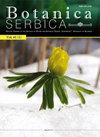用生化和蛋白质组学方法分析番茄突变体果实生长
IF 1.1
4区 生物学
Q4 PLANT SCIENCES
引用次数: 0
摘要
为了评估ABA缺乏对番茄果实生长的影响,在最佳土壤水分条件下培养ABA突变体flacca,并进行了各种分析,包括形态学(果实数量、直径和果实生物量)、生理(生长持续时间和果实生长速度)、生化(ABA积累、酶细胞壁过氧化物酶活性)和蛋白质组学。果实生长分析表明,与野生型果实相比,果实生长速度和发育速度较慢导致flacca果实较小。在果实发育过程中,细胞壁过氧化物酶活性与ABA含量的时间动态比较表明二者呈相反关系。蛋白质组学分析表明,与野生型相比,flacca果实中碳和氨基酸代谢、蛋白质翻译和加工、能量代谢和细胞壁相关代谢的大部分蛋白质下调,表明ABA突变体代谢通量降低,反映了果实生长发育缓慢和果实大小减小。这些结果还表明,ABA限制了碳源,这可能是ABA缺乏番茄果实生长和大小下降的原因。硫和进化氧促进蛋白的上调与膨胀后期光合作用的维持有关,从而减缓了向成熟阶段的过渡。flacca果实中大部分抗氧化和应激防御蛋白均下调,这可能与ABA对不同抗氧化酶活性的影响以及调控细胞壁扩张和果实生长停止的作用有关。本文章由计算机程序翻译,如有差异,请以英文原文为准。
A biochemical and proteomic approach to the analysis of tomato mutant fruit growth
To assess the effects of ABA deficiency on tomato fruit growth, the ABA mutant flacca was grown in an optimal soil water regime and various analyzes were performed, including morphological (fruit number, diameter and fruit biomass), physiological (duration of growth and fruit growth rate), biochemical (ABA accumulation, enzyme cell wall peroxidase activity) as well as proteomics. The fruit growth analysis showed that the slower fruit growth rate and development resulted in smaller flacca fruits in comparison to the wild-type fruits. The comparison of the temporal dynamics of cell wall peroxidase activity and ABA content in our experiment indicated an opposite relationship during fruit development. Proteomic analysis and the down-regulation of most proteins from carbon and amino acid metabolism, the translation and processing of proteins, energy metabolism and cell wall-related metabolism in the flacca fruits compared to the wild type, indicated reduced metabolic flux which reflected a slower fruit growth and development and reduced fruit size in the ABA mutant. These findings also indicated that ABA limited carbon sources, which could be responsible for the reduced fruit growth and size of ABA-deficient tomato fruits. The up-regulation of sulfur and oxygen-evolving enhancer proteins in the flacca fruits implicated the maintenance of photosynthesis in the late expansion phase, which slows down transition to the ripening stage. The majority of antioxidative and stress defence proteins were down-regulated in the flacca fruits, which could be related to the role of ABA in the activity of different antioxidative enzymes as well as in regulating cell wall expansion and the cessation of fruit growth.
求助全文
通过发布文献求助,成功后即可免费获取论文全文。
去求助
来源期刊

Botanica Serbica
Agricultural and Biological Sciences-Plant Science
CiteScore
1.40
自引率
12.50%
发文量
17
审稿时长
34 weeks
期刊介绍:
Botanica Serbica publishes original research papers on all aspects of plant, fungal and microbial biology research including the disciplines of microbiology, mycology, lichenology, bryology, flora, vegetation, biogeography, systematics, taxonomy, plant biotechnology, plant cell biology, plant ecology, environmental plant biology, forestry, genomics, horticulture, limnology, metabolomics, molecular biology, proteomics, virology, plant conservation and protection, and wildlife and ecosystem management.
 求助内容:
求助内容: 应助结果提醒方式:
应助结果提醒方式:


